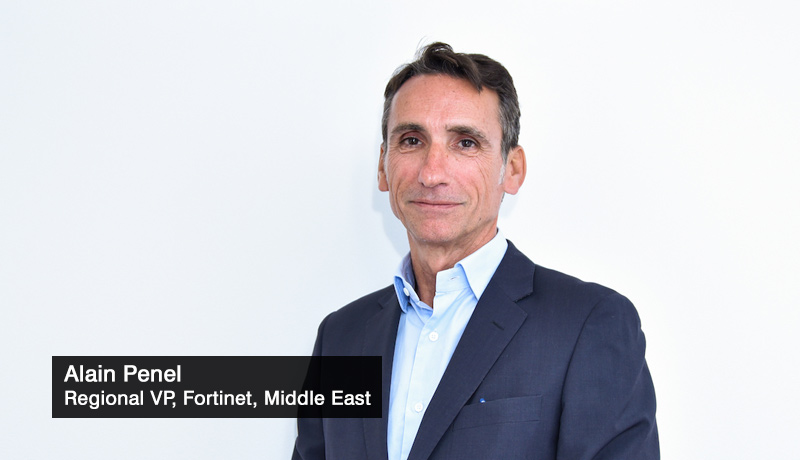
We spoke with Alain Penel, Regional VP-ME – Fortinet, as part of our pre-GITEX feature to hear about Fortinet’s expectations for the show this year, as well as to discuss Digital Transformation, FortiTrust, and Hybrid Cloud. Take a look at the responses we got.
TECHx: How excited are you for GITEX Technology Week? What are your expectations from the event this year?
Alain: We are expecting GITEX technology Week to serve as a platform for companies to encourage organizations to look at their technology investments from a new perspective; one that will ensure and improve their businesses’ overall security posture and boost businesses continuity. We are also expecting GITEX to be a mega event this year as a few tech events integrate to give visitors and exhibitors alike the opportunity to explore technology at its best. Events like this help to gather people who want to share their knowledge and help to push the global digital transformation agenda ahead.
TECHx: How does Fortinet help enterprises accomplish their digital transformation goals while maintaining security?
Alain: Digital transformation has changed networks so thoroughly and so rapidly that traditional security tools can no longer provide the consistent security that networks require. Fortinet’s Security-driven Networking is defining a new, third generation of security solutions and strategies designed to meet the security and networking demands of today’s highly dynamic and hybrid networks.
Fortinet’s Security-driven Networking strategy tightly integrates an organization’s network infrastructure and security architecture, enabling the network to scale and change without compromising security. This next-generation approach is essential for effectively defending today’s highly dynamic environments, not only by providing consistent enforcement across today’s highly flexible perimeters but by also weaving security deep into the network itself.
Fortinet’s Security-driven Network is the first security strategy designed to encompass the entire network development and deployment life cycle, ensuring that security functions as the central consideration for all business-driven infrastructure decisions. With security at the core, networks can evolve, expand, and adapt without concerns that an expanded attack surface or security gap could compromise the organization.
TECHx: Could you kindly elaborate on the integration of FortiTrust into your existing security service offerings? How does FortiTrust deal with the most pressing security issues?
Alain: Expanding on the Fortinet Security Fabric’s ability to protect people, devices and data everywhere, FortiTrust provides organizations a unified service offering to secure across any network, endpoint, or cloud with simplified consumption and one licensing model for all form factors.
FortiTrust adds to Fortinet’s existing FortiCare and FortiGuard security services portfolio. Through FortiCare, organizations have access to Fortinet experts to help accelerate technology implementation, provide reliable assistance through advanced support, and offer proactive care to maximize the security and performance of Fortinet deployments. FortiGuard Security Services provide organizations different services tied to their Fortinet devices, enabling coordinated and consistent real-time defense for the latest cyberattacks.
FortiTrust’s initial services portfolio includes FortiTrust Access and FortiTrust Identity. FortiTrust Access enables organizations to deploy zero-trust network access (ZTNA) with user-based licensing. Zero trust network access (ZTNA) is crucial to maintaining consistent protection, visibility and control across today’s hybrid and highly distributed networks. Another FortiTrust service level is FortiTrust Identity which offers cloud-based multi-factor authentication for identity verification. FortiTrust Identity complements FortiTrust Access, providing the necessary multi-factor authentication recommended for controlling application access.
The way people work has changed, networks have had to adapt. The transition to remote work and the addition of personal devices (BYOD) have led to an increase in SaaS applications and the adoption of multi-cloud networks. With FortiTrust, it is easier to protect the growing digital attack surface and secure critical devices, data, applications, and connections all the way from the data center to the cloud to the home office, and beyond.
TECHx: How can businesses incorporate security into hybrid cloud network design? What are some of the most typical mistakes they should avoid during implementation?
Alain: Despite widespread cloud adoption, many organizations still rely on their on-premises data centers. However, digital transformation has changed the look and feel of traditional data centers. Increased cloud usage is changing how organizations use their data centers. With cloud-connected data centers, the enterprise benefits from the cloud’s scalability, control, and cost savings. At the same time, it continues to gain value from its on-premises investments, highlighting the importance of hybrid cloud environments. However, security for hybrid workforces in hybrid environments fundamentally relies on end-user cyber awareness. Although organizations can put risk mitigation controls in place, people are bound to make mistakes, many of which can be costly.
As organizations look to modernize their data center security to meet these new demands, they should consider the following three strategies:
